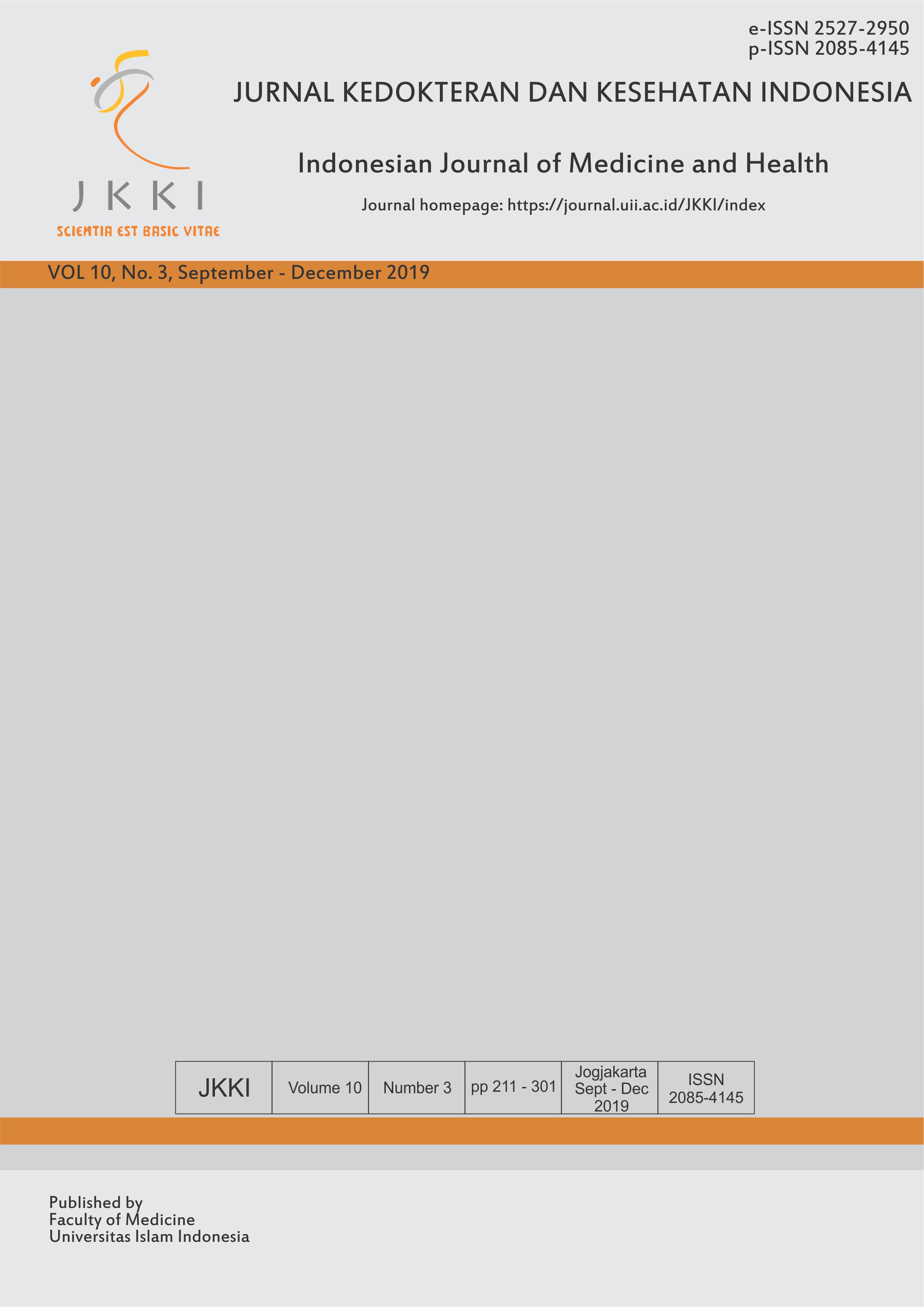Main Article Content
Abstract
Keywords
Article Details
Authors who publish in the Jurnal Kedokteran dan Kesehatan Indonesia agree to the following terms:
- Authors retain copyright and grant Jurnal Kedokteran dan Kesehatan Indonesia right of first publication with the work simultaneously licensed under a Creative Commons Attribution Licence that allows others to adapt (remix, transform, and build) upon the work non-commercially with an acknowledgement of the work's authorship and initial publication in Jurnal Kedokteran dan Kesehatan Indonesia.
- Authors are permitted to share (copy and redistribute) the journal's published version of the work non-commercially (e.g., post it to an institutional repository or publish it in a book), with an acknowledgement of its initial publication in Jurnal Kedokteran dan Kesehatan Indonesia.
References
- Alwi I, Salim S, Hidayat R, Kurniawan J, Tahapary DL. Panduan praktis klinis tirotoksikosis. Penatalaksanaan di Bidang Ilmu Penyakit Dalam. Jakarta: Interna Publishing; 2015.
- Jameson JL, Weetman AP. Disoreder of the thyroid gland. Horrison’s Principles of Internal Medicine. 18 th. New York: McGraw-Hill; 2012.
- Kurdi MS. Trophoblastic hyperthyroidism and its perioperative concerns. In: Thyroid disorders - focus on hyperthyroidism. 2014.
- Paputungan T V, Wagey FW, Lengkong RA. Profil penderita mola hidatidosa di RSUP Prof.dr.R.D. Kandou Manado. e-CliniC. 2016.
- Cunningham FG, Leveno KJ, Bloom SL, Spong CY, Dashe JS, Hoffman BL, et al. Gestational thropoblastic disease. Williams Obstetrics. 25 th. New York: McGraw-Hill; 2018. p: 388.
- Virmani S, Srinivas SB, Bhat R, Rao R, Kudva R. Transient thyrotoxicosis in molar pregnancy. Journal of Clinical and Diagnostic Research. 2017;11(7).
- Sabir A, Abubakar S, Fasanmade O, Haruna G, Iwuala S, Ohwovoriole A. Correlation between Wayne's score and laboratory evidence of thyrotoxicosis in Nigeria. Sub Saharan African Journal of Medicine. 2014;1(3):142-4.
- Samra T, Kaur R, Sharma N, Chaudhary L. Peri-operative concerns in a patient with thyroid storm secondary to molar pregnancy. Indian Journal of Anaesthesia. 2015;59(11):739-42.
- Secretariat of The Indoneisan Society of Endocrinology and Metabolism Departement of Internal Medicine. Indonesian clinical practice guidelines for hyperthyroidism. Journal of the ASEAN Federation of Endocrine Societies. 2012.
- Blick C, Schreyer K. Gestational trophoblastic disease-induced thyroid storm. Clinical Practice and Cases in Emergency Medicine. 2019; 3(4):409-12.
- Ngan HYS, Seckl MJ, Berkowitz RS, Xiang Y, Golfier F, Sekharan PK, et al. Update on the diagnosis and management of gestational trophoblastic disease. International Journal of Gynecology & Obstetrics. 2018; 143(Suppl 2):79-85.
- Filipescu GA, Solomon OA, Clim N, Milulescu A, Boiangiu AG, Mitran M. Molar pregnancy and thyroid storm - literature review. ARS Medica Tomitana. 2017;23(3):121-5.
- Simes BC, Mbanaso AA, Zapata CA, Okoroji CM. Hyperthyroidism in a complete molar pregnancy with a mature cystic ovarian teratoma. Thyroid Research. 2018;11(12):1-5.
- Hegedüs L. Treatment of graves’ hyperthyroidism: Evidence-based and emerging modalities. Endocrinology and Metabolism Clinics of North America. 2009;38(2):355-71.
- Khanna P, Dehran M, Kumar A. Gestational trophoblastic disease with hyperthyroidism: Anesthetic management. Journal of Obstetric Anaesthesia and Critical Care. 2012;2(1):31-3.
References
Alwi I, Salim S, Hidayat R, Kurniawan J, Tahapary DL. Panduan praktis klinis tirotoksikosis. Penatalaksanaan di Bidang Ilmu Penyakit Dalam. Jakarta: Interna Publishing; 2015.
Jameson JL, Weetman AP. Disoreder of the thyroid gland. Horrison’s Principles of Internal Medicine. 18 th. New York: McGraw-Hill; 2012.
Kurdi MS. Trophoblastic hyperthyroidism and its perioperative concerns. In: Thyroid disorders - focus on hyperthyroidism. 2014.
Paputungan T V, Wagey FW, Lengkong RA. Profil penderita mola hidatidosa di RSUP Prof.dr.R.D. Kandou Manado. e-CliniC. 2016.
Cunningham FG, Leveno KJ, Bloom SL, Spong CY, Dashe JS, Hoffman BL, et al. Gestational thropoblastic disease. Williams Obstetrics. 25 th. New York: McGraw-Hill; 2018. p: 388.
Virmani S, Srinivas SB, Bhat R, Rao R, Kudva R. Transient thyrotoxicosis in molar pregnancy. Journal of Clinical and Diagnostic Research. 2017;11(7).
Sabir A, Abubakar S, Fasanmade O, Haruna G, Iwuala S, Ohwovoriole A. Correlation between Wayne's score and laboratory evidence of thyrotoxicosis in Nigeria. Sub Saharan African Journal of Medicine. 2014;1(3):142-4.
Samra T, Kaur R, Sharma N, Chaudhary L. Peri-operative concerns in a patient with thyroid storm secondary to molar pregnancy. Indian Journal of Anaesthesia. 2015;59(11):739-42.
Secretariat of The Indoneisan Society of Endocrinology and Metabolism Departement of Internal Medicine. Indonesian clinical practice guidelines for hyperthyroidism. Journal of the ASEAN Federation of Endocrine Societies. 2012.
Blick C, Schreyer K. Gestational trophoblastic disease-induced thyroid storm. Clinical Practice and Cases in Emergency Medicine. 2019; 3(4):409-12.
Ngan HYS, Seckl MJ, Berkowitz RS, Xiang Y, Golfier F, Sekharan PK, et al. Update on the diagnosis and management of gestational trophoblastic disease. International Journal of Gynecology & Obstetrics. 2018; 143(Suppl 2):79-85.
Filipescu GA, Solomon OA, Clim N, Milulescu A, Boiangiu AG, Mitran M. Molar pregnancy and thyroid storm - literature review. ARS Medica Tomitana. 2017;23(3):121-5.
Simes BC, Mbanaso AA, Zapata CA, Okoroji CM. Hyperthyroidism in a complete molar pregnancy with a mature cystic ovarian teratoma. Thyroid Research. 2018;11(12):1-5.
Hegedüs L. Treatment of graves’ hyperthyroidism: Evidence-based and emerging modalities. Endocrinology and Metabolism Clinics of North America. 2009;38(2):355-71.
Khanna P, Dehran M, Kumar A. Gestational trophoblastic disease with hyperthyroidism: Anesthetic management. Journal of Obstetric Anaesthesia and Critical Care. 2012;2(1):31-3.

